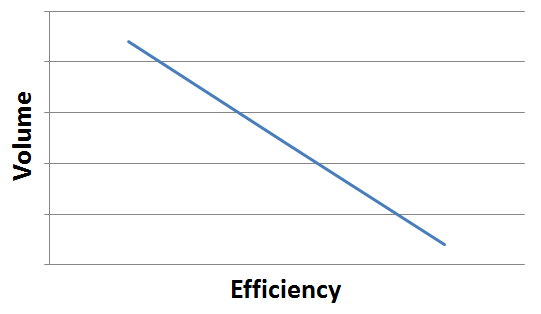Bidding forms part of the core of the Marin platform. In this article, we'll provide an overview of bidding as a concept, plus go in-depth on how you can use bidding with our platform.
In a nutshell, automated bidding solutions are designed to calculate the optimal bid (cost-per-click) for keywords, ad groups, product groups, and placements, in order to achieve a specific goal. To begin, let's cover the important concepts that influence campaign performance, and then move on to an overview of our bidding solution.
How Often Does Bidding Run?
Marin Bidding calculates bids and traffics them to the publisher every four hours.
There's no need to reach out to our customer support team to kick off bidding for existing Strategies -- this will happen automatically in the background, thanks to responsive bidding.
Volume Vs. Efficiency
Volume and efficiency have an inverse relationship if all other factors stay the same. This means that generating more volume will come at the cost of efficiency, and increasing efficiency will come at the cost of volume. This is an important concept to understand when setting up Strategies and evaluating the impact of bidding on overall performance.

Every performance-based Strategy (in other words: non-Awareness Targeting Strategies) will maximize volume based on an efficiency target or budgetary constraint.
Volume can be:
- Conversions
- Revenue
- Clicks
- Profit
Efficiency can be:
- Cost-per-Lead (CPL) which is defined as [Cost] / [Conversions]. A CPL goal allows you to maximize conversions.
- Return on Ad Spend (ROAS) which is defined as [Revenue] / [Cost]. A ROAS goal allows you to maximize revenue.
External Factors
From a bid optimization standpoint, external factors are considered to be all changes and outside forces that influence performance besides bid and bid multiplier changes. These factors can be categorized under three themes, and include:
- Campaign Optimization changes such as ad copy adjustments, geographic and audience targeting changes, and the uncontrollable quality score changes.
- Market Conditions in a real-time marketplace, which can be summed up by demand (changes in consumer behavior) and competition.
- Website Monetization, which is most often driven by web page design changes that impact the on-site conversion funnel.
These external factors can disrupt the balance between volume and efficiency in the same way that changing a bid can; potentially allowing efficiency to increase while volume increases, or causing efficiency to decrease while volume decreases. It is not possible to conclusively separate the impact of bid changes on performance from other external factors. While carefully constructed tests that attempt to hold some external factors constant can be used, market changes cannot. Tools such as Google Trends can provide directional insight (e.g. estimating consumer demand over time), but are not sufficient in providing a conclusive estimation of impact.
Bidding Algorithm
Marin offers an Algorithmic approach in addition to Awareness Targeting. Marin Bidding does not require the use of the Marin Tracker pixel and can, therefore, base bidding decisions on the tracking system (or systems) that you consider to be your source of truth.
Algorithmic bidding uses a progressive lookback and rules-based logic to calculate bids, alongside a patented Bayesian blending approach for low-volume keywords. It is the default solution in the platform and supports automated bid calculations for keywords, ad groups, product groups, and managed placements.
The algorithmic approach calculates bids in the following manner:
- A click threshold is calculated for each Strategy using a cumulative binomial distribution at an 85% statistical confidence level based on the Strategy recent conversion rate. This click threshold determines if a biddable object has enough data to stand on its own, or if additional data must be borrowed from similarly-performing keywords in order to reach the desired statistical confidence level.
- The algorithm employs a progressive lookback for each biddable object. This determines how far back in time the algorithm needs to look in order to meet the Strategy click threshold. The lookback period starts at 1 week and expands as it goes further back in time. Once the click threshold is met, the number of conversions is compared to the conversion threshold. If the conversion threshold is not yet met, the object will default to the Strategy settings for conversion metrics.
Note: The lookback starts with the most recent date with both click and conversion data and observes excluded date settings. - If a keyword can reach the click threshold on its own, the initial bid is calculated based on the Strategy target. If a keyword cannot reach the click threshold over its entire lifetime, it borrows data from similarly performing keywords in the same Strategy and uses the combined data to calculate the initial bid.
- Bid rules (e.g. Limit bid change under %) are then applied to the initial bid, resulting in the final calculated bid that is sent to the publisher.